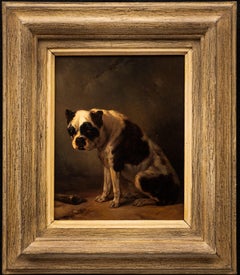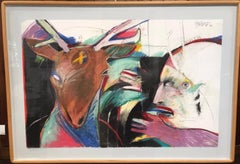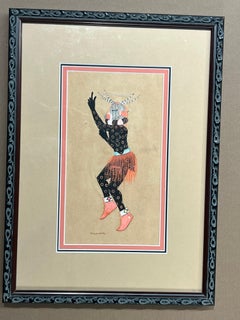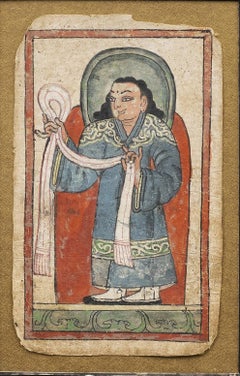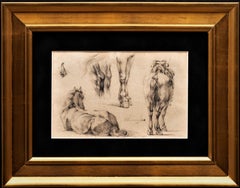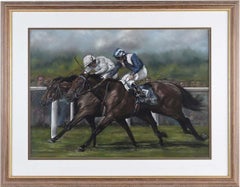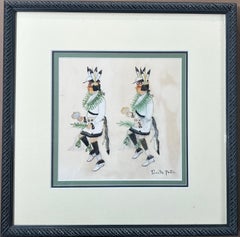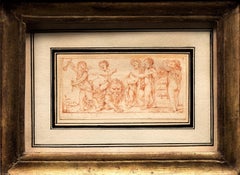New Mexico - Figurative Drawings and Watercolors
to
1
8
1
4
2
Overall Width
to
Overall Height
to
1
5
8
1
3
1
1
3
7
10
4
1
10
9
4
3
3
2
2
2
2
2
2
1
1
1
1
1
1
1
10
7
4
3
3
2
2
1
1
1
11
7,755
5,911
Item Ships From: New Mexico
Antique Dog Painting: "A Seated Bulldog" Wouterus Verschuur (Dutch, 1812-1874)
Located in SANTA FE, NM
A Seated Bulldog
Wouterus Verschuur (Dutch, 1812-1874)
Circa 1855
Oil on wood panel.
Signed on the back
9 3/8 x 7 3/8 (15 1/2 x 13 1/2 frame) inches.
The artist shows his complete g...
Category
1850s Romantic New Mexico - Figurative Drawings and Watercolors
Materials
Wood Panel, Oil
Little Deer, work on paper by Rick Bartow, red, white, pink, blue, black, green
By Rick Bartow
Located in Santa Fe, NM
Little Deer, work on paper by Rick Bartow, red, white, pink, blue, black, green,
Category
1990s Contemporary New Mexico - Figurative Drawings and Watercolors
Materials
Paper, Pastel
Corn Kachina, by Riley Sunrise, Quoyavema, Hopi, Kachina, Dancer, painting
Located in Santa Fe, NM
Corn Kachina, by Riley Sunrise, Quoyavema, Hopi, Kachina, Dancer, painting
Artist Signature - Riley Sunrise (1914-2006) Quoyavema “Another of the earlier Hopi artists, Riley Sunrise (Quoyavema) worked with Fred Kabotie and Waldo Mootzka in illustrating John Louw Nelson’s Rhythm for Rain. He is also known as Quoyavema or Kwayeshva, according to Nelson. His paintings are comparable to Fred Kabotie’s, with some of them showing more action and most of them revealing less detail. Sunrise is represented in the collections of the Denver Art Museum, Gilcrease Institute (Tulsa), and the Southwest Museum. The Museum of the American Indian in New York has an extensive collection of his paintings of native Hopi dances.” (Clara Lee Tanner: Southwest Indian...
Category
1940s Tribal New Mexico - Figurative Drawings and Watercolors
Materials
Paint, Paper
Deer Dance, painting by Tonita Pena, Santa Fe, Cochiti, Pueblo, male, female
Located in Santa Fe, NM
Deer Dance, painting by Tonita Pena, Santa Fe, Cochiti, Pueblo, male, female
Tonita Peña (born 1893 in San Ildefonso, died 1949 in Kewa Pueblo, New Mexico) was born as Quah Ah (meaning white coral beads) but also used the name Tonita Vigil Peña and María Antonia Tonita Peña. Peña was a renowned Pueblo artist, specializing in pen and ink on paper embellished with watercolor. She was a well-known and influential Native American artist and art teacher of the early 1920s and 1930s.
Tonita Peña was born on May 10, 1893, at San Ildefonso Pueblo, to Ascensión Vigil Peña and Natividad Peña of San Ildefonso Pueblo, New Mexico. When she was 12, her mother and younger sister died, as a result of complications due to the flu. Her father was unable to care for her and she was taken to Cochití Pueblo and was brought up by her aunt Martina Vigil Montoya, a prominent Cochití Pueblo potter. Peña attended St. Catherine Indian School in Santa Fe.
Edgar Lee Hewett, an anthropologist involved in supervising the nearby Frijoles Canyon excavations (now Bandelier National Monument) was instrumental in developing the careers of several San Ildefonso “self-taught” artists including Tonita Peña. Hewett purchased Peña's paintings for the Museum of New Mexico and supplied her with quality paint and paper. Peña began gaining more notoriety by the end of the 1910s selling an increasing amount of her work to collectors and the La Fonda Hotel. Much of this early work was done of Pueblo cultural subject matter, in a style inspired by historic Native American works, however, her use of an artist's easel and Western painting mediums gained her acceptance among her European-American contemporaries in the art world. At the age of 25, she exhibited her work at museums and galleries in the Santa Fe and Albuquerque area.
In the early 1920s, Tonita did not know how much her painting sold for at the Museum of New Mexico, so she wrote letters to the administrators because a local farmer was worried that she got paid too little.
In the 1930s Peña was an instructor at the Santa Fe Indian School and at the Albuquerque Indian School and the only woman painter of the San Ildefonso Self-Taught Group, which included such noted artists as Alfonso Roybal, Julian Martinez, Abel Sánchez (Oqwa Pi), Crecencio Martinez, and Encarnación Peña. As children, these artists attended San Ildefonso day school which was part of the institution of the Dawes Act of 1887, designed to indoctrinate and assimilate Native American children into mainstream American society.
In 1931, Tonita Peña exhibited at the Exposition of Indian Tribal Arts which was presented at the Grand Central Art Galleries in New York City. Works from this exhibition were shown at the 1932 Venice Biennial. That year is the only time Native American artists have shown in the official United States pavilion at that biennial, and Tonita Peña's paintings were part of that exhibition.[1 Her painting Basket Dance, that had shown in the Venice Biennial was acquired by the Whitney Museum of American Art in New York for $225. This was the highest price paid up to this time for a Pueblo painting...
Category
1940s Tribal New Mexico - Figurative Drawings and Watercolors
Materials
Paint, Paper
15th C. Tibetan Tsakali: "High Lama Presenting a Ceremonial Scarf"
Located in SANTA FE, NM
15th C. Tibetan Tsakali
"High Lama Presenting a Ceremonial Scarf"
MIneral pigne
6 1/4 x 4 (16 x 13 3/4 frame) inches
Category
15th Century and Earlier New Mexico - Figurative Drawings and Watercolors
Materials
Gouache, Handmade Paper
Antique Horse Study; Legs and Rumps, 1838" Wouterus Verschuur (Dutch, 1812-1874)
Located in SANTA FE, NM
Antique Horse Study
"Legs and Rumps, 1838"
Wouterus Verschuur l (Dutch, 1812-1874)
Pencil on paper
Signed and Dated "W Verschuur 1838"
10 x 6 1/2 (17 1/2 x 14 frame) inches
In his time Wouterus Verschuur was an acclaimed and celebrated painter of horses. Through careful observation he learned to capture their physique and movement to perfection. As a true-born romanticist he was also interested in their character, thereby painting powerful carthorses in their stable, thoroughbred saddled horses during an afternoon ride or harnessed horses in action.
He was born to an Amsterdam jeweler and received his training from the landscape and cattle painters Pieter Gerardus van Os and Cornelis Steffelaar. As part of this education Verschuur had to copy works by the 17th century painter Philips Wouwerman. Like Wouwerman, Verschuur's subjects consist mostly of stable scenes, landscapes with horses and coastal landscape. These works reflect the enduring influence of the northern Baroque masters on nineteenth century art, revealing the artist's close study of his Dutch and Flemish predecessors harking back to Peter Paul Rubens.
Showing talent from a very early age, at 15 Verschuur had a painting exhibited at the "Exhibition of Living Masters" at Amsterdam in 1828. In 1832 and 1833 he won the gold medal at the annual exhibition at Felix Meritis. In 1833 he was appointed a member of the Royal Academy in Amsterdam. In 1839 he joined the artists' society, Arti et Amicitiae.
His reputation was also considerable abroad. He was often featured in the annual exhibitions which travelled the large European cities at that time. In 1855 Napoleon III purchased one of his paintings at the Exposition Universelle in Paris.
The Verschuur horse revels in its physicality, like a quintessential Baroque horse...
Category
1830s Romantic New Mexico - Figurative Drawings and Watercolors
Materials
Pencil, Paper
Kachina Figures, by Dan Namingha, green, black, framed, Hopi, drawing, katsina
By Dan Namingha
Located in Santa Fe, NM
Kachina Figures, by Dan Namingha, green, black, framed, Hopi, drawing, katsina
Category
1970s Contemporary New Mexico - Figurative Drawings and Watercolors
Materials
Charcoal, Watercolor
Untitled
By Rudolph Carl Gorman
Located in Santa Fe, NM
UNTITLED
charcoal on paper unique
©1969 R.C. Gorman
Category
1960s Contemporary New Mexico - Figurative Drawings and Watercolors
Materials
Charcoal
$7,600 Sale Price
36% Off
Antique Horse "Heads, Hooves, Rump 1838" Wouterus Verschuur (Dutch, 1812-1874)
Located in SANTA FE, NM
Antique Horse Study
"Heads, Hooves and Rump, 1838"
Wouterus Verschuur (Dutch, 1812-1874)
Pencil on paper
Signed and Dated "W Verschuuur 1838"
10 x 6 1/2 (17 1/2 x 14 frame) inches
In his time Wouterus Verschuur was an acclaimed and celebrated painter of horses. Through careful observation he learned to capture their physique and movement to perfection. As a true-born romanticist he was also interested in their character, thereby painting powerful carthorses in their stable, thoroughbred saddled horses during an afternoon ride or harnessed horses in action.
He was born to an Amsterdam jeweler and received his training from the landscape and cattle painters Pieter Gerardus van Os and Cornelis Steffelaar. As part of this education Verschuur had to copy works by the 17th century painter Philips Wouwerman. Like Wouwerman, Verschuur's subjects consist mostly of stable scenes, landscapes with horses and coastal landscape. These works reflect the enduring influence of the northern Baroque masters on nineteenth century art, revealing the artist's close study of his Dutch and Flemish predecessors harking back to Peter Paul Rubens.
Showing talent from a very early age, at 15 Verschuur had a painting exhibited at the "Exhibition of Living Masters" at Amsterdam in 1828. In 1832 and 1833 he won the gold medal at the annual exhibition at Felix Meritis. In 1833 he was appointed a member of the Royal Academy in Amsterdam. In 1839 he joined the artists' society, Arti et Amicitiae.
His reputation was also considerable abroad. He was often featured in the annual exhibitions which travelled the large European cities at that time. In 1855 Napoleon III purchased one of his paintings at the Exposition Universelle* in Paris.
The Verschuur horse revels in its physicality, like a quintessential Baroque horse...
Category
1830s Romantic New Mexico - Figurative Drawings and Watercolors
Materials
Pencil, Paper
Gahn Portrait # 121, Darren Vigil Gray, pastel on paper, black, red, Apache
By Darren Vigil Gray
Located in Santa Fe, NM
Gahn Portrait # 121, Darren Vigil Gray, pastel on paper, black, red, Apache
painting on paper
signed and titled by the artist on the front
Category
1990s Contemporary New Mexico - Figurative Drawings and Watercolors
Materials
Paint, Paper
Gahn Portrait 39, Darren Vigil Gray Apache dancer, work on black paper Indian
By Darren Vigil Gray
Located in Santa Fe, NM
Gahn Portrait 39, Darren Vigil Gray Apache dancer, work on black paper
Category
1990s Contemporary New Mexico - Figurative Drawings and Watercolors
Materials
Paper, Pastel
Drawing of Putti with Anchor by Jean-Jacques le Barbier l'Ainé (1738-1826)
By Jean Jacques Francois Le Barbier
Located in SANTA FE, NM
Drawing of Putti with Anchor
Jean-Jacques le Barbier l'Ainé (1738-1826)
Black pencil on paper
Signed and dated lower left "...1822. 12 years l waiting"
Considering that the anchor ...
Category
1820s Academic New Mexico - Figurative Drawings and Watercolors
Materials
Paper, Pencil
Drawing of Putti in the Clouds by Jean-Jacques le Barbier l'Ainé (1738-1826)
By Jean Jacques Francois Le Barbier
Located in SANTA FE, NM
Drawing of Putti in the Clouds
Jean-Jacques le Barbier l'Ainé (France, 1738-1826)
Black pencil on paper
Signed and dated lower left "Le Barbier L'ainé 1816"
10 1/4 x 12 1/4 inches ...
Category
1810s Academic New Mexico - Figurative Drawings and Watercolors
Materials
Paper, Pencil
Knowing Some History, mixed media monotype, by Melanie A Yazzie, Navajo, unique
By Melanie Yazzie
Located in Santa Fe, NM
Knowing Some History, mixed media monotype, by Melanie A Yazzie, Navajo, unique
As a printmaker, painter, and sculptor, my work draws upon my rich Diné (Navajo) heritage. The work I...
Category
2010s Contemporary New Mexico - Figurative Drawings and Watercolors
Materials
Pastel, Monotype
Apache Woman on Horseback, by Allan Houser, Haozous, painting, paper, horse
By Allan Houser
Located in Santa Fe, NM
Apache Woman on Horseback, by Allan Houser, Haozous, painting, paper, horse
Painting on paper from 1946 by master artist Allan Houser. Ft. Sill Chi...
Category
1940s Contemporary New Mexico - Figurative Drawings and Watercolors
Materials
Watercolor
Related Items
Original Pastel Drawing of Horse Race at Royal Ascot 2002 with Golan & Nayef
Located in Preston, GB
Original Pastel Drawing on Paper of Horse Race at Royal Ascot 2002 with Golan & Nayef
Art measures 25 x 18 inches
Frame measures 33 x 26 inches
Nayef was pipped by Golan in the 2...
Category
Late 20th Century Contemporary New Mexico - Figurative Drawings and Watercolors
Materials
Paper, Oil Pastel, Pastel
$1,860 Sale Price
30% Off
H 26 in W 33 in D 1 in
"Dragon, " Original Pastel Drawing
By Quang Ho
Located in Denver, CO
"Dragon," by Quang Ho, is a secondary market work with one previous owner. It is signed and dated (1988) on the lower left. The painting comes with it's original frame (measures 50 x...
Category
20th Century American Realist New Mexico - Figurative Drawings and Watercolors
Materials
Paper, Pastel
Expressionist Figurative water color painting- Series Bath NO.1
Located in Beijing, CN
Artist Biography
Zhang Chunyang was born in 1975 in Changchun, Jilin. She earned her B.F.A at Jilin University of Arts in 1999, and studied at Central Acadamy of Fine Arts, Beijing ...
Category
2010s Expressionist New Mexico - Figurative Drawings and Watercolors
Materials
Watercolor, Gouache, Handmade Paper
$3,040
H 11.42 in W 14.18 in
Grazing Horse - Oil Paint by Sirio Pellegrini - 1960s
Located in Roma, IT
Oil pastel on paper realized by Sirio Pellegrini in 1960s.
Very good condition.
Includes a coeval wooden frame cm. 52x61.5.
Sirio Pellegrini, born in Rome on March 1, 1922, of Abr...
Category
1960s Contemporary New Mexico - Figurative Drawings and Watercolors
Materials
Oil Pastel, Laid Paper
$2,141 Sale Price
25% Off
H 13.39 in W 17.72 in D 0.04 in
Fenzoni, Painting AND preparatorial Drawing, John the Baptist, Italy Renaissance
By Ferrau Fenzoni
Located in Greven, DE
The painting and the preparatory drawing are offered together.
Provenance
Private collection, Germany, Trier, c. 1980- 2013
Saint John the Baptist
Brown ink and wash over red chalk on oatmeal paper
31 x 20.5 cm
Inscribed: „Ferrau Fenzonio da Faenza invt. esque … imp. da Fran. Villamena …“.
bears the collector's mark of Henry Scipio Reitlinger (1882-1950; Lugt 2274a) on a tiny label glued to the verso
On the reverse is a partial drawing of a Pieta, pricked for transfer.
Provenance
New York, Doyle, 14. October 2015, No. 6
The painting and the preparatory drawing resemble the composition of an engraving after Ferraù Fenzoni by Francesco Villamena. Drawing, engraving and painting are almost identical, except for minor differences. Even the measurements nearly correspond: painting (32 x 25,5 cm), drawing (30 x 20,5 cm), engraving (31,1 x 23,5 cm).
Dr. Guiseppe Scavizzi confirmed the attribution of the present panting to Fenzoni and he dates it to c. 1590.
The inscription on the drawing reads “Ferrau Fenzonio da Faenza invt. esque. . . imp. da Fran: Villamena . . .”. The engraving’s inscription also lists place and date “Ferra Fensionius inventor/F. Villamoena sculpsit Rome/Aspectu fruitur… antra puer/cum Privilegio… 1613”.
Interestingly, the engraving is not mirrored as it is in most printing processes. Painting, drawing and engraving are not reversed but the same. It is remarkable to note that there are further paintings by Fenzoni which were engraved in the same order and not reverted. They also show strong parallels regarding the compositions and the measurements (see for example “Deposition of Christ” ).
Ferraù Fenzoni was an Italian painter mainly active in Todi. He is also called Il Faenzone after his birthplace (Faenza). He apprenticed in Rome during the papacy of Gregory XIII and contributed to numerous fresco cycles under pope Sixtus V, such as the Loggia della Benedizioni in the Lateran Palace, the frescoes on the walls and vaults of the Scala Santa of the adjacent Basilica of San Giovanni in Laterano, and the decoration in the Sistine library. His expressive canvases straddle the styles of Mannerism and Baroque. In 1594, he moved to Todi. A “Last Judgement” by him is housed in the cathedral of Todi. He returned to Faenza in 1599, where he decorated chapels in the cathedral from 1612 to 1616. In 1622, he completed a “Deposition”, now in the local Pinacoteca. In 1640, Fenzoni was named “cavaliere dello speron d’oro” by Cardinal Colonna and, on 25th April 1634, he was nominated vicar and “castellano of Granarolo”.
Fenzoni‘s style is characterized by a mixture of the Mannerism of the Northern Netherlands and the Italian Baroque.
Saint John the Baptist, Old Master, 17th Century, By Fenzoni, Religious Scene, Rome Art...
Category
16th Century Mannerist New Mexico - Figurative Drawings and Watercolors
Materials
Canvas, Oil, Handmade Paper
Ferrau FenzoniFenzoni, Painting AND preparatorial Drawing, John the Baptist, Italy Renaissance, 1590
$28,554 Sale Price
25% Off
H 12.21 in W 8.08 in
Henri-Louis Dupray (1841-1909) Studies of military horsemen, two signed drawings
By Henry Louis Dupray
Located in Paris, FR
Henri-Louis Dupray (1841-1909)
Studies of military horsemen, two signed drawings
Pencil on paper
The first one figuring a partial study of two horsemen :
10.8 x 16.5 cm, bears a mo...
Category
1880s Romantic New Mexico - Figurative Drawings and Watercolors
Materials
Pencil
Fine 1700's Italian Old Master Ink & Wash Drawing Roman Allegorical Africa
Located in Cirencester, Gloucestershire
'Africa'
Italian School, 18th century
ink and wash drawing on paper, framed within a light oak wood frame (behind glass)
image size: 10.5 x 7 inches
overall framed: 17 x 13 inches
co...
Category
18th Century Old Masters New Mexico - Figurative Drawings and Watercolors
Materials
Ink, Watercolor, Archival Paper
African American Woman artist Mailou Jones Cezannian Cote d'Azur cubist village
Located in Norwich, GB
If you are interested in African American Art and in Women in the Arts, I will certainly not need to introduce Lois Mailou Jones (1905-1988). Often associated with the Harlem Renaissance, her
work can be found in the collections of the Smithsonian American Art Museum, The Metropolitan Museum of Art, the National Museum of Women in the Arts, the Brooklyn Museum, the Museum of Fine Arts, Boston, Muscarelle Museum of Art, and The Phillips Collection. I am proud to present an original watercolour painting by the artist which dates from the late 1940s or early 1950s.
Jones was born in Boston, Massachusetts to a father who became the first African-American to earn a law degree from Suffolk Law School. Jones's parents encouraged her to draw and paint using watercolors during her childhood. She held her first solo exhibition at the age of seventeen in Martha's Vineyard.
He career began in the 1930s and she continued to produce art work until her death in 1998 at the age of 92. Her style shifted and evolved multiple times in response to influences in her life, especially her extensive travels. She felt that her greatest contribution to the art world was "proof of the talent of black artists". Her work echoes her pride in her African roots and American ancestry.
In 1937, Jones received a fellowship to study in Paris at the Académie Julian, bringing her to France for the first time. The French were appreciative of her paintings and talent and Loïs Mailou Jones was thrilled at the country’s racial tolerance, so different from her reality in the United States.
She summered in France annually from 1945 to 1953, sharing studio with her lifelong friend Celine Marie Tabary in Cabris, France.
It was during one of these sojourns that the lovely work presented here was created.
Our painting depicts the village of Tourettes sur Loup, just north of Nice, in the Provence Cote d'Azur region, about 14 miles from Cabris.
Please note its similarities with her painting "Arreau, Hautes-Pyrénées" in the National Museum of Women in the Arts.
Her portrayal of the picturesque village nestled in a valley evokes landscape paintings by Paul Cézanne, a stylistic influence she acknowledged.
Over the course of the following 10 years, Jones exhibited at the Phillips Collection, Seattle Art Museum, National Academy of Design, the Barnett-Aden Gallery, Pennsylvania's Lincoln University, Howard University, galleries in New York, and the Corcoran Gallery of Art. In 1952, the book Loïs Mailou Jones: Peintures 1937–1951 was published, reproducing more than one hundred of her art pieces completed in France.At the Barnett-Aden Gallery, Jones exhibited with a group of prominent black artists, such as Jacob Lawrence and Alma Thomas. These artists and others were known as the "Little Paris...
Category
Mid-19th Century American Modern New Mexico - Figurative Drawings and Watercolors
Materials
Watercolor, Gouache, Handmade Paper
$6,800
H 29.93 in W 25.79 in D 1.19 in
Fine 1700's Italian Old Master Ink & Wash Drawing Roman Allegorical Napoli
Located in Cirencester, Gloucestershire
'Napoli'
Italian School, 18th century
ink and wash drawing on paper, framed within a light oak wood frame (behind glass)
image size: 10.5 x 7 inches
overall framed: 17 x 13 inches
co...
Category
18th Century Old Masters New Mexico - Figurative Drawings and Watercolors
Materials
Ink, Watercolor, Archival Paper
Circus Rider, Acrobat
By Simka Simkhovitch
Located in Greenwich, CT
Simkhovitch was a celebrated artist in New York City from the 1920's through the 1940's. Life Magazine did a story on him and he was having great success in the New York Galleries. ...
Category
1920s American Realist New Mexico - Figurative Drawings and Watercolors
Materials
Paper, Graphite
19th Century French School, Studies of horses and small scenes, original drawing
Located in Paris, FR
19th Century French School,
Studies of horses and small scenes,
pencil on paper
14.5 x 21 cm
Framed : 25.5 x 32.7 cm
This study sheet, which brings together studies of horses and...
Category
1850s Romantic New Mexico - Figurative Drawings and Watercolors
Materials
Pencil
$416
H 5.71 in W 8.27 in
Contemporary Drawing "The essential". Pastel, Ink And Colored Pencils
Located in Bogotá, Bogotá
Drawing based on natural pigments from leaves, flowers and bark and Pastel, Pencil, flower petals, Color and Ink on Paper. In my work there is a cross with the gaze of animals, a rem...
Category
2010s Contemporary New Mexico - Figurative Drawings and Watercolors
Materials
Oil Pastel, Ink, Pencil, Color Pencil, Paper
Previously Available Items
Pueblo Dancers, painting, by Tonita Pena, Cochiti, Pueblo, Santa Fe, Native Amer
Located in Santa Fe, NM
Pueblo Dancers, painting, by Tonita Pena, Cochiti, Pueblo, Santa Fe, Native Amer
Tonita Peña (born 1893 in San Ildefonso, died 1949 in Kewa Pueblo, New Mexico) was born as Quah Ah (meaning white coral beads) but also used the name Tonita Vigil Peña and María Antonia Tonita Peña. Peña was a renowned Pueblo artist, specializing in pen and ink on paper embellished with watercolor. She was a well-known and influential Native American artist and art teacher of the early 1920s and 1930s.
Tonita Peña was born on May 10, 1893, at San Ildefonso Pueblo, to Ascensión Vigil Peña and Natividad Peña of San Ildefonso Pueblo, New Mexico. When she was 12, her mother and younger sister died, as a result of complications due to the flu. Her father was unable to care for her and she was taken to Cochití Pueblo and was brought up by her aunt Martina Vigil Montoya, a prominent Cochití Pueblo potter. Peña attended St. Catherine Indian School in Santa Fe.
Edgar Lee Hewett, an anthropologist involved in supervising the nearby Frijoles Canyon excavations (now Bandelier National Monument) was instrumental in developing the careers of several San Ildefonso “self-taught” artists including Tonita Peña. Hewett purchased Peña's paintings for the Museum of New Mexico and supplied her with quality paint and paper. Peña began gaining more notoriety by the end of the 1910s selling an increasing amount of her work to collectors and the La Fonda Hotel. Much of this early work was done of Pueblo cultural subject matter, in a style inspired by historic Native American works, however, her use of an artist's easel and Western painting mediums gained her acceptance among her European-American contemporaries in the art world. At the age of 25, she exhibited her work at museums and galleries in the Santa Fe and Albuquerque area.
In the early 1920s, Tonita did not know how much her painting sold for at the Museum of New Mexico, so she wrote letters to the administrators because a local farmer was worried that she got paid too little.
In the 1930s Peña was an instructor at the Santa Fe Indian School and at the Albuquerque Indian School and the only woman painter of the San Ildefonso Self-Taught Group, which included such noted artists as Alfonso Roybal, Julian Martinez, Abel Sánchez (Oqwa Pi), Crecencio Martinez, and Encarnación Peña. As children, these artists attended San Ildefonso day school which was part of the institution of the Dawes Act of 1887, designed to indoctrinate and assimilate Native American children into mainstream American society.
In 1931, Tonita Peña exhibited at the Exposition of Indian Tribal Arts which was presented at the Grand Central Art Galleries in New York City. Works from this exhibition were shown at the 1932 Venice Biennial. That year is the only time Native American artists have shown in the official United States pavilion at that biennial, and Tonita Peña's paintings were part of that exhibition.[1 Her painting Basket Dance, that had shown in the Venice Biennial was acquired by the Whitney Museum of American Art in New York for $225. This was the highest price paid up to this time for a Pueblo painting...
Category
1940s Tribal New Mexico - Figurative Drawings and Watercolors
Materials
Paint, Paper
Old Masters Sanguine Drawing of Putti and a Lion, 18th century
Located in SANTA FE, NM
Old Masters Sanguine Drawing of Putti and a Lion
18th century
4 3/4 x 3 1/4 (8 5/8 x 7 1/4 frame) inches
An utterly charming depiction in sanguine of 5 putti and a lion on a leash. Excellent details and condition. The innermost frame is period and probably original to the piece with the addition of a later frame added for style.
Though the lion, known as the Marzocco, was the symbol of of a free Republic of Florence, it also carried many biblical meanings as well.
As such, That a lion denotes the good of celestial love and the derivative truth, in its power, and also that in the opposite sense it denotes the evil of the love of self in its power, is evident from passages in the Word where a lion is mentioned. That it denotes the good of celestial love is evident in John:--
"Behold the lion that is of the tribe of Judah, the root of David, hath conquered to open the book, and to loose the seven seals thereof (Rev. 5:5);"
Here the Lord is called a lion from the omnipotence belonging to His Divine love and the Divine truth thence derived. In other passages in the Word, Jehovah or the Lord is compared to a lion, as in Hosea:--
"They shall go after Jehovah; He shall roar like a lion; for Be shall roar, and the sons shall come with honor from the sea (Hosea 11:10)."
Even more interesting still is the association with Cherubs (or perhaps Putti as they are closely related)...
In Isaiah:--
"Thus said Jehovah unto me, Like as when the lion roareth, and the young lion over his prey, if a fulness of shepherds come running upon him, he is not dismayed at their voice, and is not afflicted by their tumult; so shall Jehovah Zebaoth come down to fight upon Mount Zion...
Category
Early 18th Century Old Masters New Mexico - Figurative Drawings and Watercolors
Materials
Paper, Chalk, Ink
H 7.13 in W 8.63 in D 1.5 in
Recently Viewed
View AllMore Ways To Browse
Sebastian Pether
Seema Kohli
Shai Azoulay
Sigg Vintage
Signed Pearblossom Highway David Hockney
Sigurd Skou
Sir Alfred James Munnings October Meeting
Snooker Painting
Soey Milk
Sophie Rude
Spoonbill Oil Painting On Canvas
Staffordshire Bull Terrier
Staffordshire Terrier
Stanley Tivoli
Stephen Beal
Stephen L Winer
Stig Wernheden
Stirling Engine
